The latest edition of our For The Record newsletter is our Induction Special highlighting the 2023 Induction Class. Tickets can be purchased on our website or book accommodations at our partner hotel The Atlas.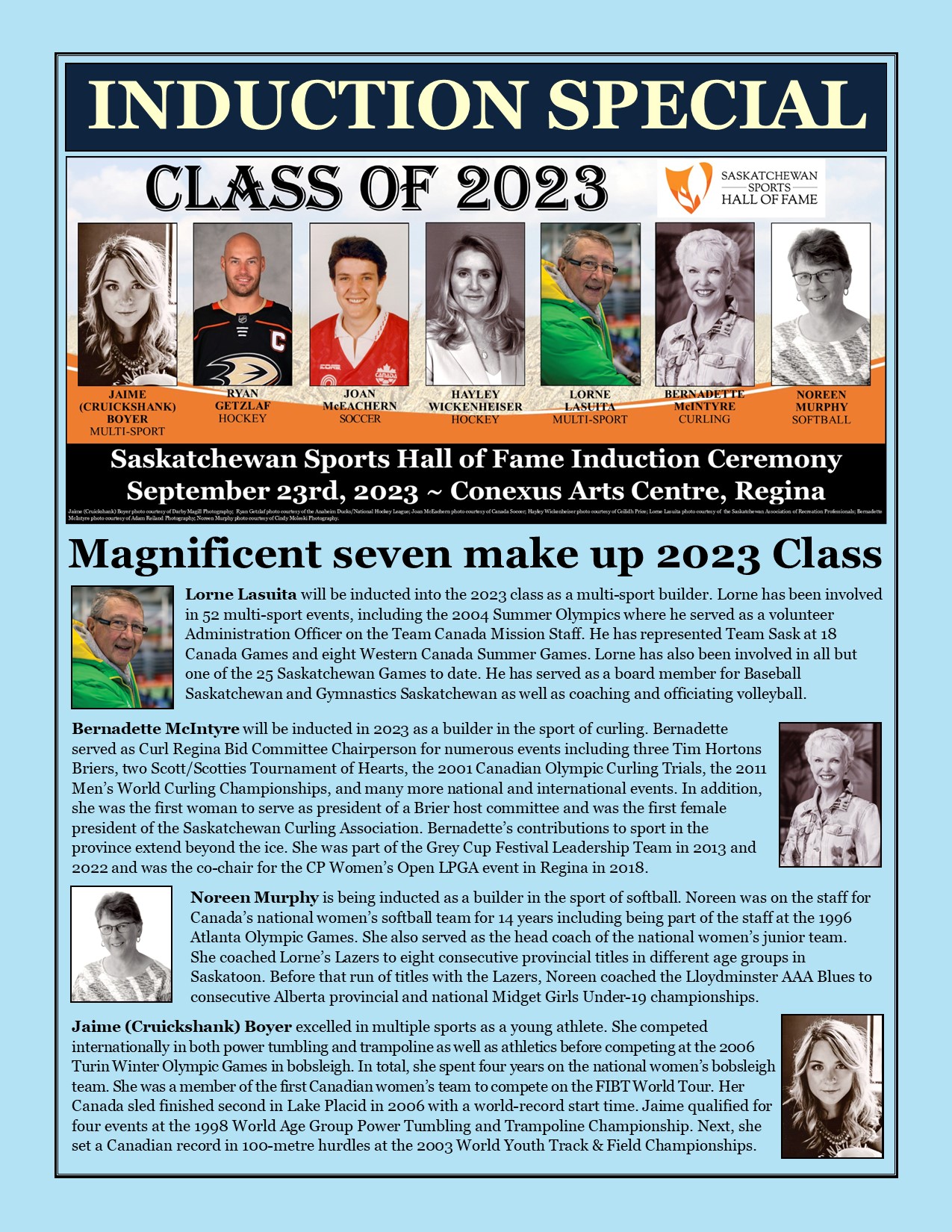
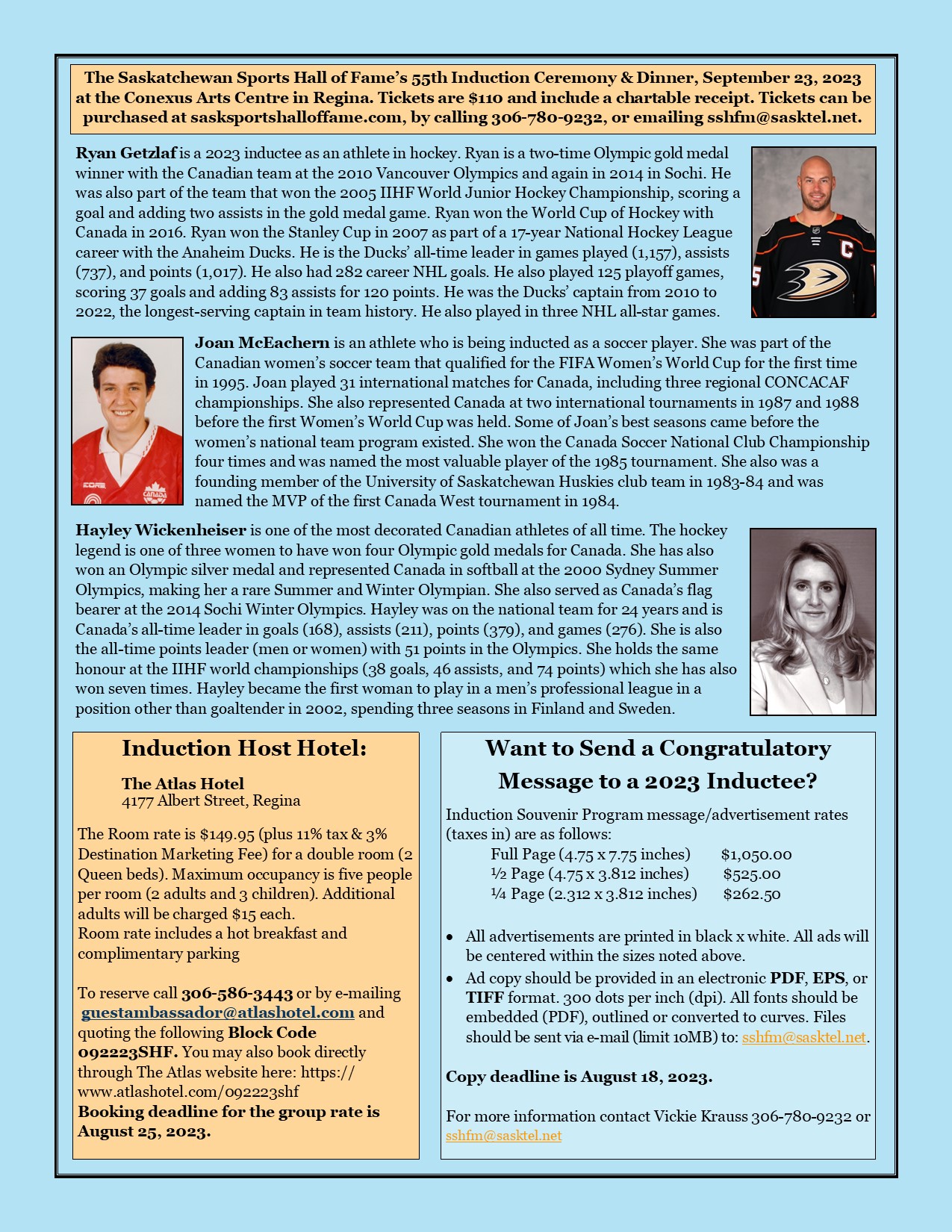

The latest edition of our For The Record newsletter is our Induction Special highlighting the 2023 Induction Class. Tickets can be purchased on our website or book accommodations at our partner hotel The Atlas.


The Saskatchewan Sports Hall of Fame (SSHF) is pleased to announce the seven (7) inductees who will become the newest members of the SSHF this fall.
The 55th Annual Induction Dinner & Ceremony at the Conexus Arts Centre in Regina on Saturday, September 23, 2023. Tickets are now available by completing the form at the bottom of this page.
The Class of 2023 features four inductees in the athlete category and three in the builder category.
The 2023 inductees are:
IN THE ATHLETE CATEGORY:
Jaime (Cruickshank) Boyer (Saskatoon) – Multi-sport
Ryan Getzlaf (Regina) – Hockey
Joan McEachern (Leroy) – Soccer
Hayley Wickenheiser OC (Shaunavon) – Hockey
IN THE BUILDER CATEGORY:
Lorne Lasuita (Wynyard) – Multi-sport
Bernadette McIntyre (Bethune) – Curling
Noreen Murphy (Saskatoon) – Softball
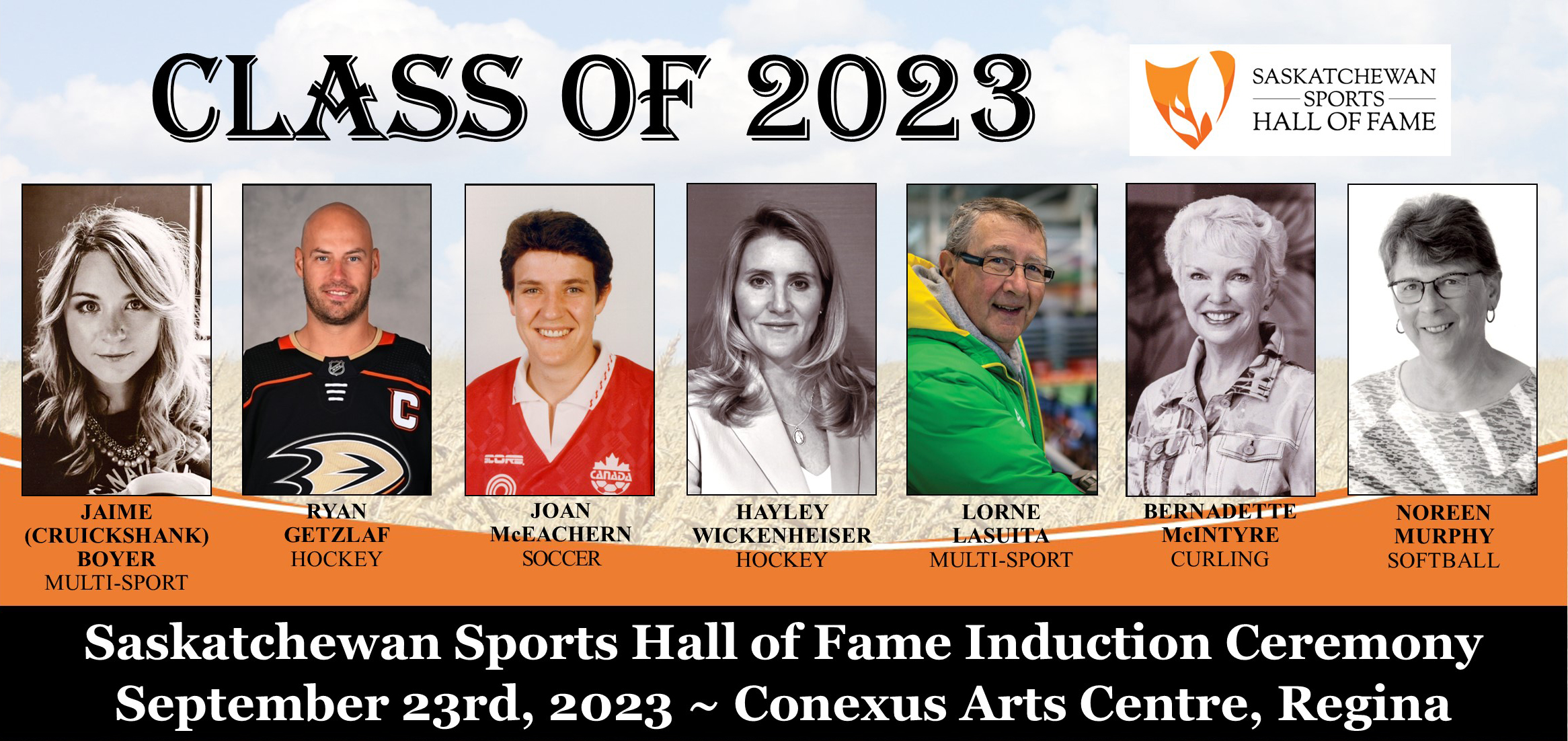
This incredible induction class includes three Olympic athletes – two of which won multiple gold medals – and a member of the first Canadian team to compete at the FIFA Women’s World Cup. The three builders each have decades of experience contributing to the growth of sport in the province.
Jaime (Cruickshank) Boyer competed internationally in both power tumbling and trampoline as well as athletics as a young athlete before competing at the 2006 Turin Winter Olympics in bobsleigh.
Ryan Getzlaf won a pair of Olympic gold medals in men’s hockey (2010 & 2014) as part of eight international competition he took part in. Getzlaf also won the Stanley Cup in 2007 as part of a 17-year National Hockey League career with the Anaheim Ducks.
Joan McEachern was part of the Canadian squad that made their debut at the FIFA Women’s World Cup in 1995. She won the Canada Soccer National Club Championship four times during the pre-professional era of women’s soccer.
Hayley Wickenheiser is one of the most decorated Canadian athletes of all time. She has won four Olympic gold medals and a silver medal in women’s hockey and also represented Canada in softball in the Summer Olympics. Wickenheiser is Canada’s all-time leader in goals, assists, points and games played. She is also the all-time points leader in the Olympics and the IIHF world championships which she has also won seven times.
Lorne Lasuita has been involved in 52 multi-sport events, including the 2004 Summer Olympics. He has represented Team Sask at 18 Canada Games and has been involved in all but one of the 25 Saskatchewan Games to date.
Bernadette McIntyre was the bid committee chairperson for the Olympic Curling Trials, the men’s world curling championship, three Briers, and two Scotties in Regina. She also was the co-chair of the 2018 LPGA CP Women’s Open and was part of the Grey Cup festival leadership team in 2013 and 2022.
Noreen Murphy was on the staff for Canada’s national softball for 14 years including the 1996 Atlanta Olympic Games. She was also the head coach of the national junior team. She won eight provincial titles in eight years as a coach in Saskatoon as part of her storied coaching career.
The Atlas Hotel (4177 Albert Street, Regina) is the host hotel for the 2023 Induction Dinner & Ceremony.
The Atlas’ cancellation policy is as follows:
The Block hold will be released on August 25, 2023. Individuals can still reserve rooms but now it will depend on availability and may be at a different rate.
Tickets are no longer available for this event.

Kids out of school and don’t know what to do? Come and hang out and have some fun at the Saskatchewan Sports Hall of Fame (SSHF)!
The SSHF is offering a new program during the Easter break to encourage kids to have fun and keep active.
Schools Out! is a 90-minute program that will run from April 11-14 and is being offered at 9:30 a.m. and 1:30 p.m. at the Hall of Fame (2205 Victoria Ave., Regina). The program will feature a guided tour of the Hall of Fame’s exhibits and then plenty of time to play and enjoy our multi-sport simulator, adaptive curling ice, and the STEM Interactive Gallery sponsored by SaskTel. The program will also feature ABC activities and allow time at the end to play and explore on your own.
Visitors to the STEM Interactive Gallery can test their vertical jump, their balance, their strength, their standing long jump, their flexibility, and their grip strength at our STEM stations. The multi-sport simulator is a popular favourite that allows visitors to test their sporting skills in a variety of virtual games like baseball, basketball, football, hockey, soccer, and more. Our four-rock adaptive curling “ice” allows visitors to slide their stones down the ice either from their knees or with an adaptive stick that affixes to the stone.
The Hall of Fame’s featured exhibit is Fanfare, while the Dedication to Sport exhibit celebrates our 13 newest inductees.
Participation for one adult and one child requires a $5 donation. Each additional visitor (whether adult or child) requires another $2 donation. We ask that children be accompanied by an adult for the duration of their visit and the adults are welcome to participate as well. This program is best suited for children between the ages of 4-12. Water bottles are recommended as the water fountain in our foyer is not available to the public. Clean indoor shoes are also recommended.
Donations are non-refundable. We thank you for your understanding. Participants will receive a tax receipt for the cost of their donation.
If you have any questions, please email our Education Coordinator Vickie Krauss at [email protected] or call 306-780-9232.
There is a maximum of 20 spots available for each of the eight offerings of the program. Please reserve your space in the program by filling out the form below.

The Saskatchewan Sports Hall of Fame was proud to unveil their new touch table and 3D artifact display case Thursday.
The SSHF partnered with Twisted Pair Productions of Regina for this next stage in our Hall of Fame Gallery development. The new touch table and a 3D artifact display case allows visitors more access to the Hall of Fame’s collection of artifacts and information on our inductees.
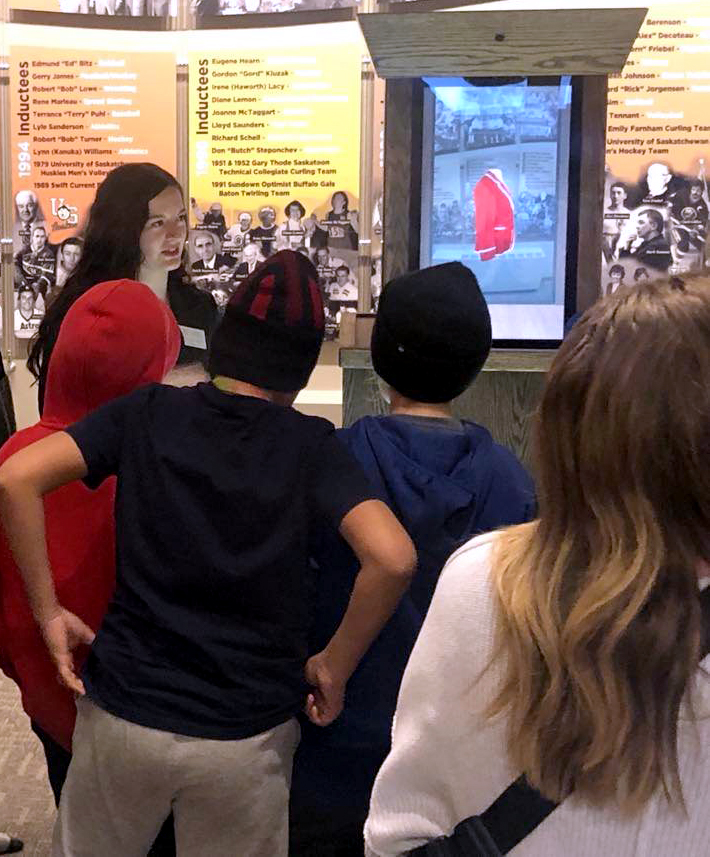
“We are delighted to see this project come to fruition. Through a generous donation from the Estate of Jordana Buchan and funding support from the Government of Canada and the Government of Saskatchewan, we are now able to provide our visitors with unprecedented access to our permanent collection at one time. In a facility with very limited exhibit space, this is a significant visitor enhancement. The touch table content and 3D exhibit case allow visitors to immerse themselves in Saskatchewan’s sport history and really self-direct what they want to explore,” said Saskatchewan Sports Hall of Fame Executive Director Sheila Kelly. “Additionally, the ability to continually update and expand the content available allows us so much more flexibility in how we interpret the sport history than our physical space allows.”
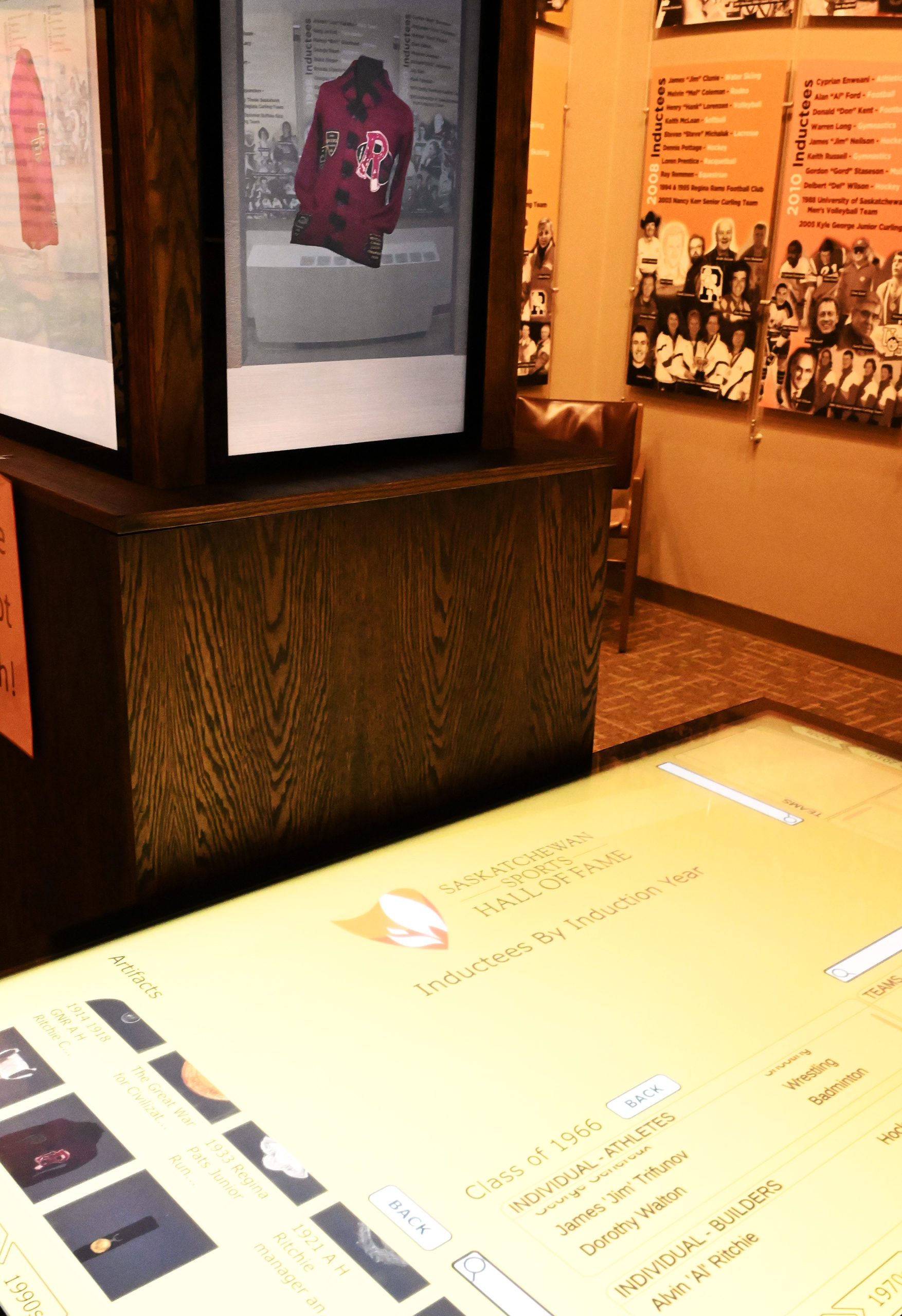
More than 500 artifacts were photographed and then rendered in a 3D format for the new display case. The images of the artifacts can be manipulated and rotated within the case so visitors can view more of the SSHF’s impressive permanent collection at once than can be physically displayed at any one time.
The touch table features information on each of the Hall of Fame’s 540 inductees. The information is organized in timelines that bring the history of Saskatchewan sport to our visitors’ fingertips.
This project has been in development for five years and has taken 15 months of dedicated curatorial time to reach completion. This project would not have been possible without the funding support of the following individuals and organizations: the Estate of Jordana (Ball) Buchan, the Government of Canada, the Government of Saskatchewan, Twisted Pair Productions, and Queen City Electrical.
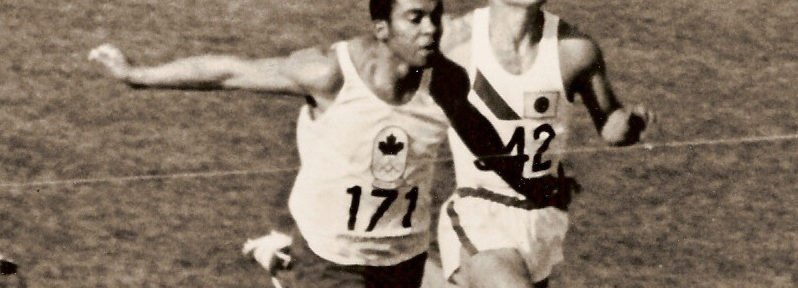
February is African-Canadian Black History Month and this year the Saskatchewan Sports Hall of Fame is pleased to launch a new educational outreach program History of Black Athletes and Their Impact on Saskatchewan Sport.
The new program is being offered to schools across the province year-round as part of the SSHF’s educational programming.
History of Black Athletes shares the stories of pioneers like Robert Ellis “Stonewall” Jackson who became the first black player to suit up for the Roughriders on October 25, 1930, against the Moose Jaw Maroons. Jackson had a 45-yard run and recovered a fumble for a Riders touchdown in an auspicious debut. Jackson became the first black player to play in Grey Cup when the Riders faced Balmy Beach in Toronto in 1930. Jackson worked his day job as a railway porter on the trip from Regina to Toronto before playing the game and working on the trip back home.
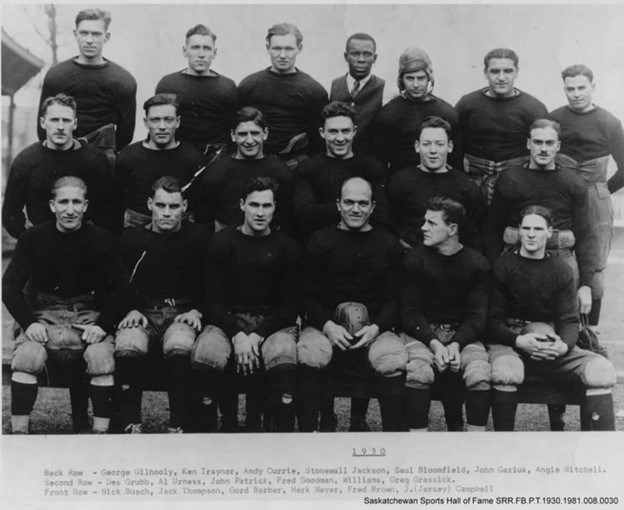
The 1930 Regina Roughriders.
Players like Gabe Patterson in 1947, Chester “Cookie” Gilchrist in 1958, and Ed Buchanan and George Reed in 1963 came north to play football with the Riders and continued to break down barriers as they battled discrimination. Reed has related that he lived in a hotel for his first two years in Regina because he couldn’t find a landlord who would rent an apartment to him.
The History of Black Athletes program also highlights the stories of two recent inductees.
Harry Winston Jerome, OC had an incredible athletic career that was even more remarkable considering the adversity he faced.
Jerome was born in Prince Albert and when he was 12, the family settled in North Vancouver, B.C. There, locals tried to block the sale of a house to the Jerome family because of their race. The Jerome siblings had rocks thrown at them on their first day of school.
At the age of 19, Jerome burst into the global spotlight when he matched the world record time in the 100-metre sprint at the Canadian Olympic trials in Saskatoon. At the 1960 Rome Olympics, Jerome pulled up with a hamstring injury in the 100m semifinal. Several newspapers in Canada questioned his character with one even labelling him as a “quitter.”
At the 1962 British Empire and Commonwealth Games, Jerome tore his quadriceps tendon and pulled up lame to finish last in the 100-yard final. The injury was so severe that he missed an entire year of competition. Even today an injury of that nature would be difficult to return from, but in 1962 it was unheard of and it was feared that Jerome’s career was over.
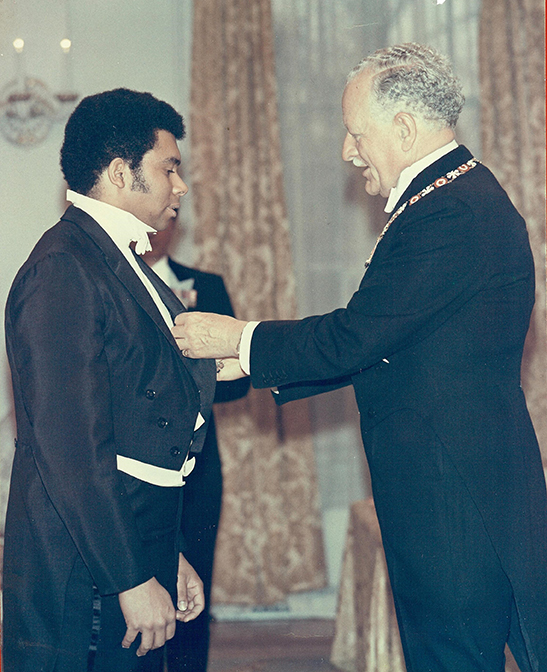
Harry Jerome receives the Order of Canada. photo courtesy of the BC Sports Hall of Fame
Instead, he returned to competition and silenced any critics he had with an incredible comeback that spoke to his character. He won an Olympic bronze medal at the 1964 Tokyo Olympics and won the 100m gold at the British Commonwealth Games in 1966.
In total Jerome owned seven different world records over his career. He also completed his master’s degree in Education at the University of Oregon (where he was also a decorated sprinter) and after retiring in 1969, Prime Minister Pierre Trudeau asked him to help create Canada’s new Ministry of Sport.
He was made an Officer of the Order of Canada in 1970 and was named British Columbia’s Athlete of the Century. Today a statue of Jerome is prominently displayed in Stanley Park in Vancouver.
The National Film Board of Canada has an excellent documentary about Harry Jerome entitled Mighty Jerome by Ileana Pietrobruno. She also made a short film for the NFB, titled Harry Jerome: The Fastest Man on Earth which is available below:
Harry Jerome : The Fastest Man on Earth, Ileana Pietrobruno, provided by the National Film Board of Canada
Rueben Mayes’ family history is a fascinating chapter in the story of the province. A group of black families – some of whom were freed slaves – left Oklahoma in 1910 with the promise of affordable land and the hope of finding a more accepting place to call home. The group named themselves the Shiloh people, named after the Biblical town where the once-enslaved Israelites rested on their search for the Promised Land after fleeing Egypt. They settled just north of Maidstone between Lloydminster and North Battleford.
Mayes’ great-grandfather Joe Mayes was the minister of Shiloh Baptist Church which was built by the settlers and is now a heritage site. Rueben’s great-grandmother Mattie Mayes was a midwife, an educator and a spiritual leader in the community. Approximately 1,000 African-Americans came to Saskatchewan as part of the migration, but in 1912, the Canadian government began discouraging black immigration. They went so far as to send emissaries to black communities in America to dissuade them from coming to Saskatchewan.
Rueben Mayes would be born in North Battleford in 1963 and would go on to become one of the greatest football players ever produced in Canada. He became the first Canadian to be a finalist for the Heisman Trophy representing the best college football players in America. He was a consensus All-American in 1984 and broke the NCAA’s single-game rushing record that same year for Washington State.
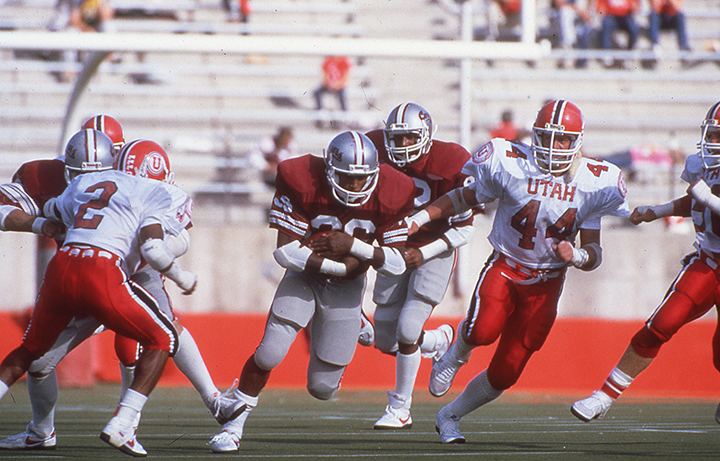
Rueben Mayes runs to daylight with Washington State. photo courtesy Washington State University
Mayes would go on to play six seasons in the National Football League. He was the NFL Offensive Rookie of the Year and was named to the Pro Bowl team twice while playing for the New Orleans Saints.
Like Jerome, Mayes would go on to complete his Master’s degree, completing an MBA after retiring.
The Black Business and Professional Association created the Harry Jerome Awards in 1983 shortly after Jerome died. For more than 40 years the Harry Jerome Awards have celebrated black achievement in Canada in a dozen categories from business and entrepreneurship to sports and the arts. Mayes himself was honoured with a Harry Jerome Award.
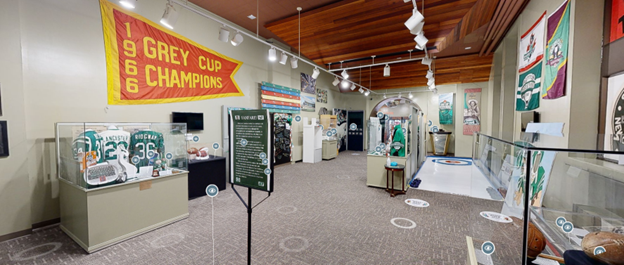
Fanfare, the Saskatchewan Sports Hall of Fame’s featured exhibit, is now available as a virtual tour.
This exhibit shares the history of the Grey Cup and Saskatchewan both through the participation of Roughrider teams and also the four occasions where Regina has hosted the Canadian Football League’s championship game. Fanfare features some of the 16mm film footage that the Hall of Fame had digitized recently. The exhibit also celebrates the festival of fun around Grey Cup week and the communal qualities of professional football in Saskatchewan.
This virtual tour was created in partnership with Queen City 3D in Regina. The tour allows the user to navigate through the space of the exhibit and click on tags inside the tour that offer stories, photos and videos that complement the physical exhibit that is on display.
The SSHF’s full archive of virtual tours is available on the Virtual Tour page.
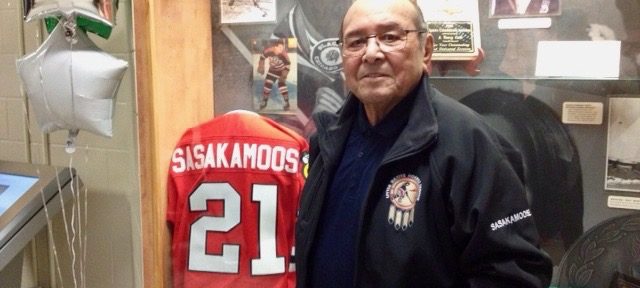
On this National Day for Truth and Reconciliation, the Saskatchewan Sports Hall of Fame is marking the day by highlighting how two Indigenous inductees achieved their great success and achievements while enduring the effects of the residential school system.
The federal holiday was created to honour the lost children and survivors of residential schools, their families and communities. In the spirit of the Truth and Reconciliation Commission of Canada’s 87th Call to Action, the Saskatchewan Sports Hall of Fame is reflecting on some of the ways the residential school system affected our inductees. We share two of those stories here as part of our learning and reflection on our shared history.
Fred Sasakamoose was born on Christmas Day, 1933 on the Big River First Nation and would move to what is now the Ahtahkakoop Cree Nation when he was very young.
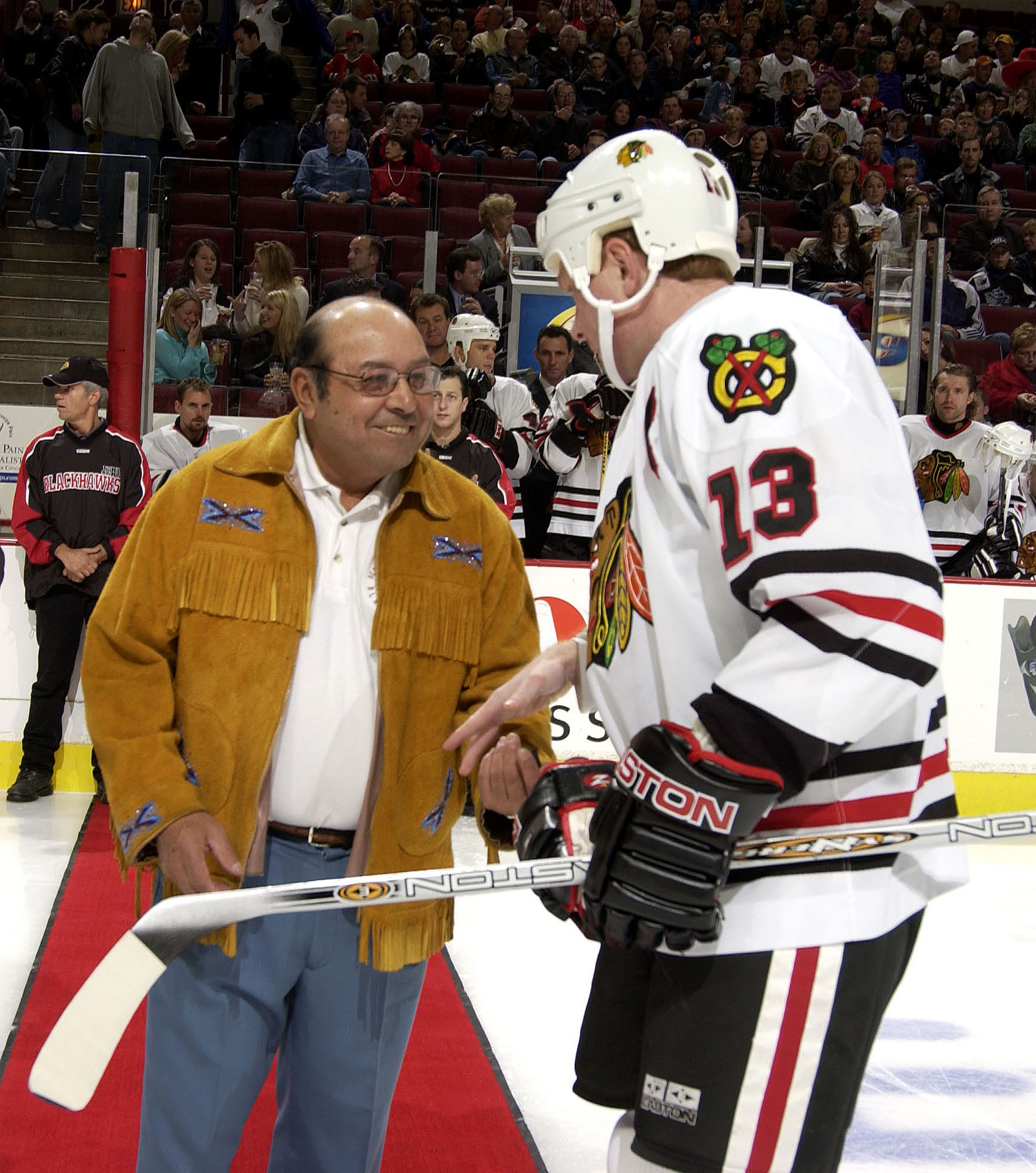
Fred Sasakamoose, left, shakes hands with Chicago Blackhawks captain Alexei Zhamnov.
In his 2021 autobiography Call Me Indian: From the Trauma of Residential School to Becoming the NHL’s First Treaty Indigenous Player Saskamoose speaks candidly about his experience of being taken from his home at a young age to be placed in a residential school.
He discusses how important his family and community were in his life. His grandfather, his Moosum, Alexan, carved Fred’s first hockey stick out of a long willow branch. The young Saskamoose would skate on a frozen lake while his Moosum – who was deaf and did not speak – would ice fish and keep an eye on him.
Fred Sasakamoose wrote in Call Me Indian:
This was my world. A nēhiyaw world. A nēhiyaw life.
What I knew was that home was full of song, dance, and tradition. It was full of wonder and mystery. It was full of family, love, and community.
And then one day, in 1941, when I was just seven, all of that was taken away.
‑‑‑
To be honest, I don’t remember a lot about the beginning of that last day of my childhood. I don’t know what Frank and I were doing, only that we were outside. My father was home, chopping wood out back. I remember that, at least. And it was fall. Perhaps we were helping dig potatoes out of the ground before the first hard frosts touched them. I don’t know. The twins must have been in the cabin. Maybe three-year-old Peter was with them. It felt like a normal day, the kind you have over and over until they all blend together, stretching to the edges of memory.
Everything is a bit cloudy until the moment a huge canvas-covered grain truck appears in front of our little cabin. Three men get out of the cab. One I recognize — the reserve’s Indian agent. Another is wearing a uniform. An RCMP officer. And the third is a pale white man with a hard face. He is wearing a long black robe that billows slightly behind him as he walks. He’s talking to my mother, and my father is coming around to the front of the cabin, but I can’t make out what anyone is saying. All I can hear is the sharp, jagged sound of crying. Crying children. It’s coming from under the canvas of the truck.
And then someone is lifting the canvas flaps at the back of the vehicle. And one of the men is grabbing Frank and lifting him into the truck. My moosum is pulling me in behind his back, is standing in front of me with his arms spread. I’m peeking around him, and I see one of the men coming towards us. My grandpa tries to push him away, but he’s swept aside and falls to the ground. My strong, protective moosum, the man who is mighty enough to lift the front end of a workhorse clear off the ground, is shoved aside as if he is nothing. And then I’m being hoisted into the crush of crying, trembling children. I can see my moosum struggling to get up. He is making desperate sounds, sounds I have never heard before. My mother is hanging on to my father, her shoulders heaving. My big, strong father looks helpless.
The last thing I see before the engine starts and the flaps are dropped in front of me is my moosum, lying on the ground, shaking and crying.
And then we are gone.
Fred Sasakamoose and his brother Frank were among a group of 30 other children who were taken to the St. Michael’s Indian Residential School in Duck Lake more than 100 kilometres away. The abuse and indoctrination were immediate upon arriving.
Saskamoose wrote:
And then we were being hustled into the building. Frank and I were separated. We were marched into a room where nuns set about cutting off our beautiful braids with huge pairs of scissors and shaving off the rest of our hair with clippers. Then we were forced to take our clothes off and shuffle into a windowless brick-walled room. There, coal oil, the stuff we used in our lamps at home, was poured over our bare heads. The foul-smelling liquid dripped into my ears, stung my eyes, burned down my back.
Hot steam began to billow out from a pipe near the ceiling of the small room. Water, soap, scrub brushes. After all those hours in the filthy truck, I guess some of the kids needed a good bath. But this wasn’t a bath. It felt like those nuns and priests were trying to scrub the colour right off our skin. As if they didn’t care that my mother made sure we were washed every day, our hair clean and brushed, carefully braided, neatly tied at the ends.
Sasakamoose’s further descriptions of life at the residential school are a difficult, but important read.
Despite all that he suffered as a child, Sasakamoose excelled as a hockey player and reached the National Hockey League as a 19-year-old in 1953 with the Chicago Black Hawks. In doing so, Sasakamoose became the first Indigenous person with Treaty status to play in the NHL.
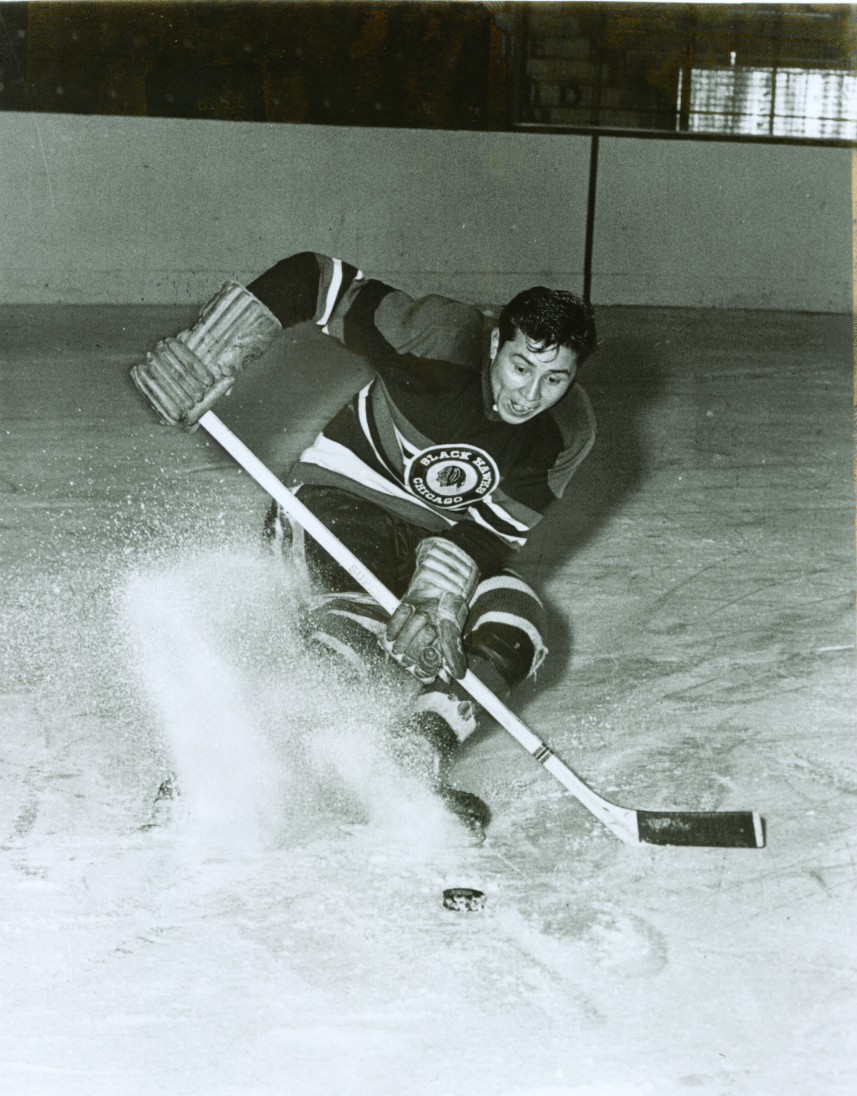
Fred Sasakamoose with the Chicago Black Hawks Photo Courtesy : Hockey Hall Of Fame
Sasakamoose would spend 35 years as a Band Councillor of the Ahtahkakoop Cree Nation, six as Chief. He worked to give back to his community and build and develop minor hockey and other sports there.
Saskamoose’s book is available here and his story is both important and inspiring. It is worth reading in its entirety, as are the numerous other stories and testimony that chronicles the experience at residential schools.
The Saskatchewan Sports Hall of Fame currently has 10 individual athletes who identify as Indigenous and have been inducted. Those athletes and builders are: Paul Acoose, Colette Bourgonje, Tony Cote, Alex Decoteau, David Greyeyes, Jacqueline Lavallee, Jim Neilson, Claude Petit, Fred Sasakamoose, and Bryan Trottier.
In addition to the individual Indigenous inductees, the SSHF also has inductees who were members of an inducted team.
Kenneth Moore, from the Peepeekisis Cree Nation, was inducted into the SSHF as a member of the 1930 Regina Pats hockey team that won the Memorial Cup. Moore is also the first Indigenous athlete to win an Olympic gold medal.
Moore was the third of eight kids born in 1910. His two older brothers had been taken to the Brandon Indian Residential School in Manitoba – more than 300 kilometres away. The two older Moore brothers died at the Brandon Indian Residential School with no details or cause provided to the family. Kenneth would have been forced to attend the school when he turned seven. Instead, the Moore family fled the Peepeekisis Cree Nation in the middle of the night.
The family settled in Regina, which was still more than 100 km from their home reserve, but the younger Moore children were able to avoid the residential school system.
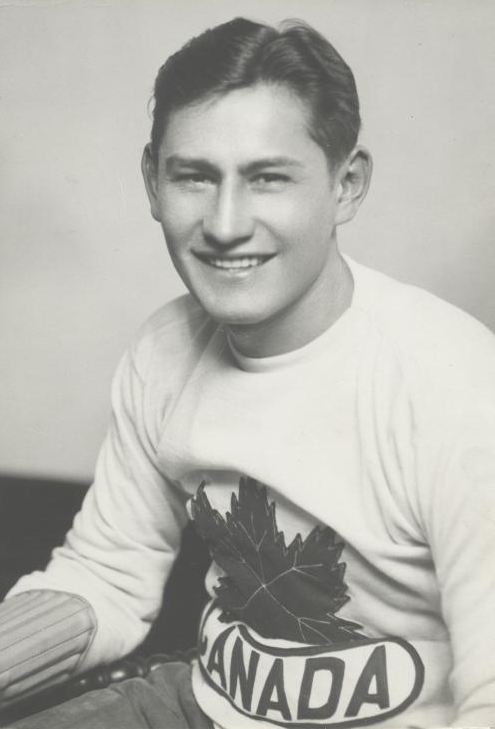
Ken Moore
Ken Moore would star as a right winger on the Regina Pats junior hockey team. In 1930, the Pats met the West Toronto Nationals in the Memorial Cup final. Moore would score the game-winning goal with 40 seconds left which gave the Pats the series win and their third Memorial Cup in six years. He also attended Campion College and Regina College on a scholarship where he captained the hockey and rugby teams.
Moore later joined the Winnipeg Hockey Club and help them claim the 1931 Allan Cup, the national amateur hockey championship. As Allan Cup champions, Winnipeg also earned the right to represent Canada at the 1932 Olympic Winter Games in Lake Placid, New York. Canada won five games and tied one to earn their fourth straight Olympic gold medal in hockey.
These stories from our inductees are just a small example of the countless ways the residential school system impacted the indigenous population.
The Saskatchewan Sports Hall of Fame is proud to be physically located in Treaty 4 territory, which is home to the Cree, Dakota, Lakota, Nakota, and Saulteaux people since time immemorial and are the traditional homelands of the Métis Nation. The Saskatchewan Sports Hall of Fame also celebrates the history of sport and the people from the land that is covered by Treaties 2, 4, 5, 6, 8, and 10. These lands have been the home of the Cree, Dakota, Dene, Lakota, Nakota, and Saulteaux people since time immemorial and are the traditional homelands of the Métis Nation.
Today the Saskatchewan Sports Hall of Fame pauses to reflect on the enduring history of the residential school system in Canada, but we are dedicated to listening to and learning from the First Nations every day as we commit to moving towards reconciliation.
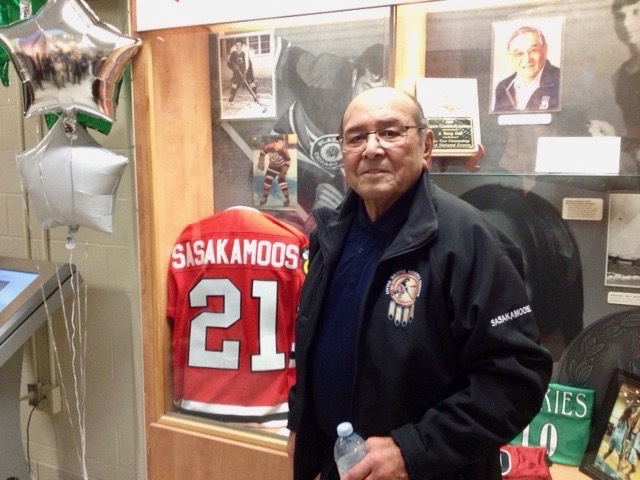
Fred Sasakamoose at the opening of the SSHF’s Indigenous sport exhibit at the University of Saskatchewan. David Stobbe/StobbePhoto.ca
To that end, the SSHF wants to continue to preserve and share the history of Saskatchewan’s Indigenous athletes. The Saskatchewan Sports Hall of Fame has a display case and video kiosk celebrating Saskatchewan Indigenous athletes and their achievements on permanent display in the Physical Activity Complex at the University of Saskatchewan’s College of Kinesiology in Saskatoon.
Our nomination process is open to the public and if you believe you know of an athlete, builder or team that deserves inclusion in the Hall of Fame we invite you to nominate them. You can learn more about that process here.

The latest edition of the Saskatchewan Sports Hall of Fame’s newsletter, For The Record, is now available. You can find a PDF version here or read it below.
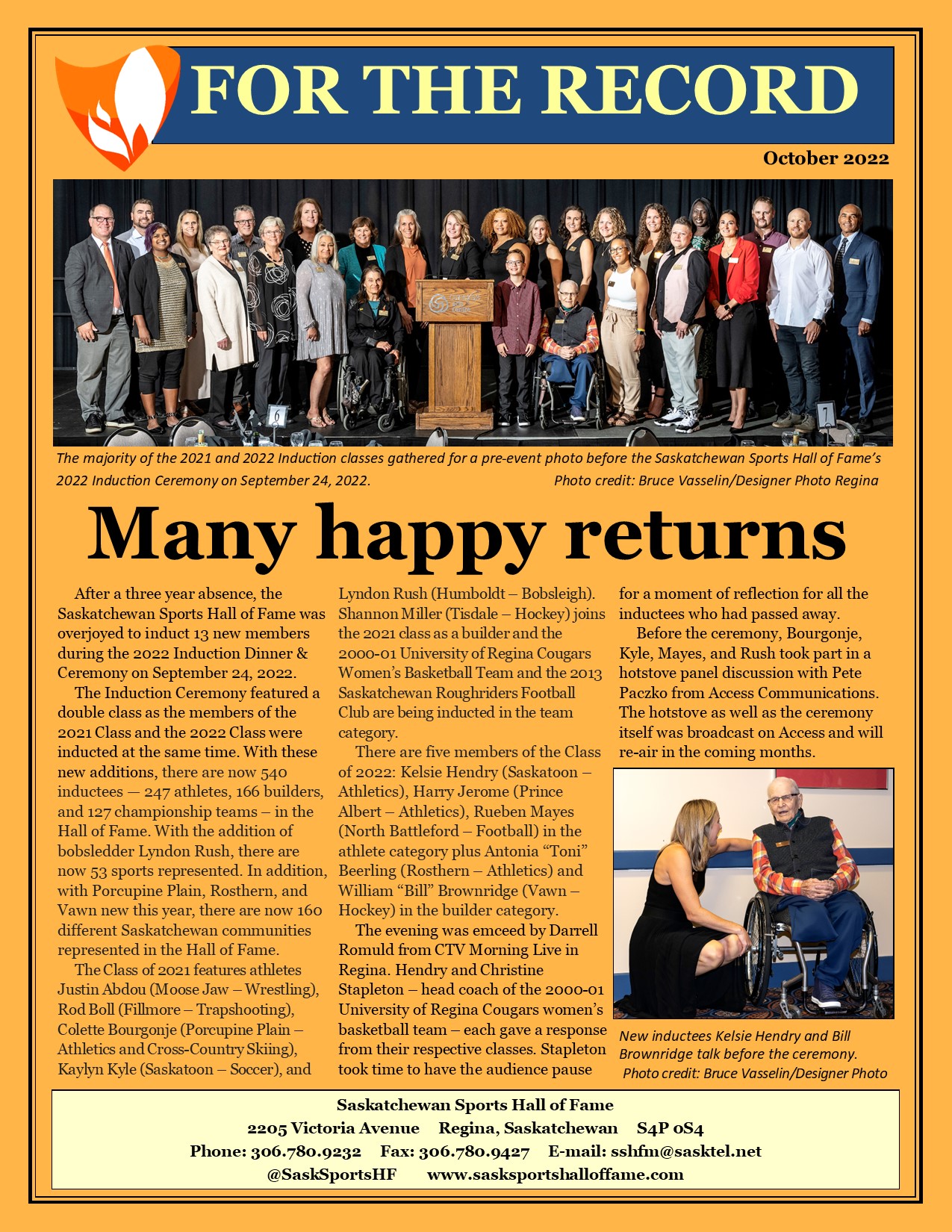
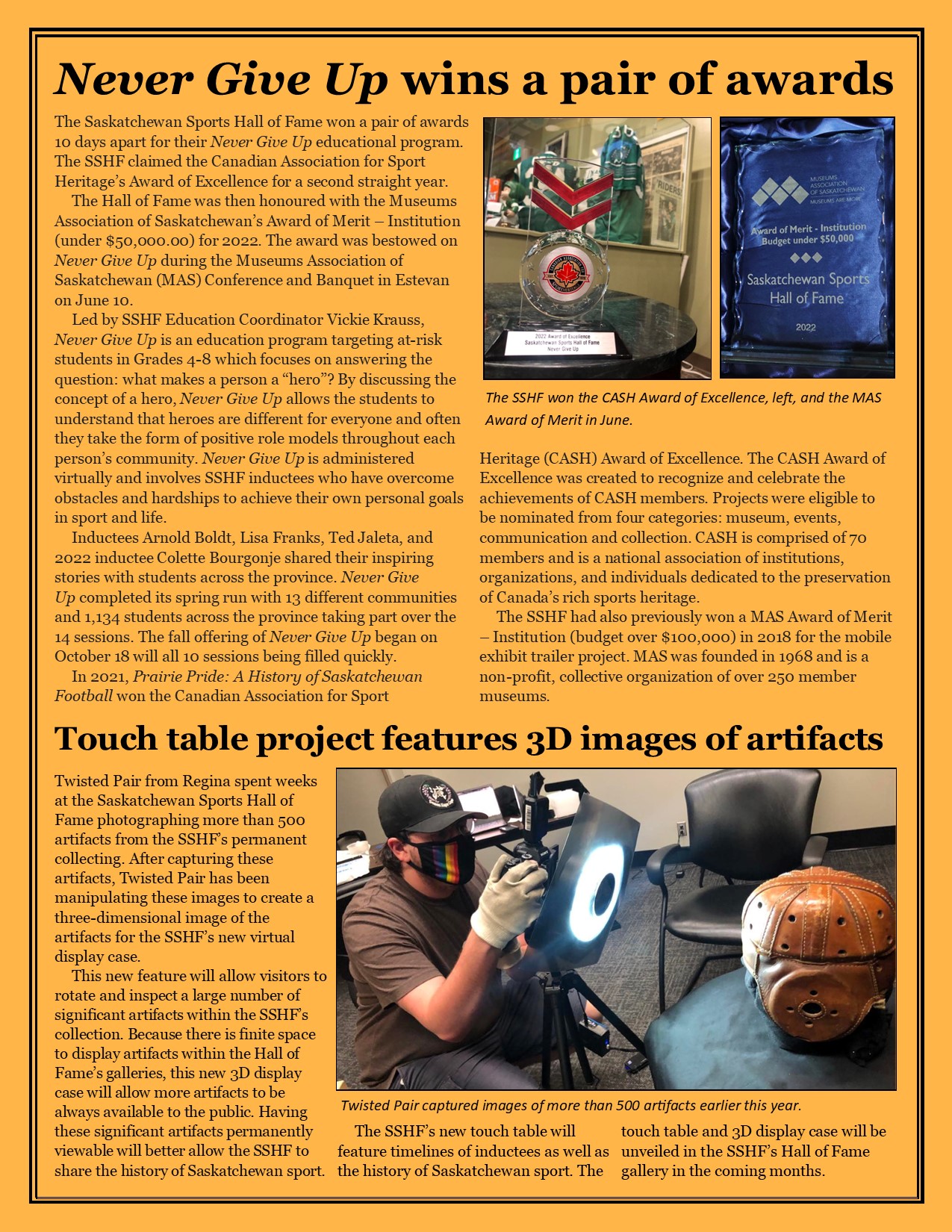
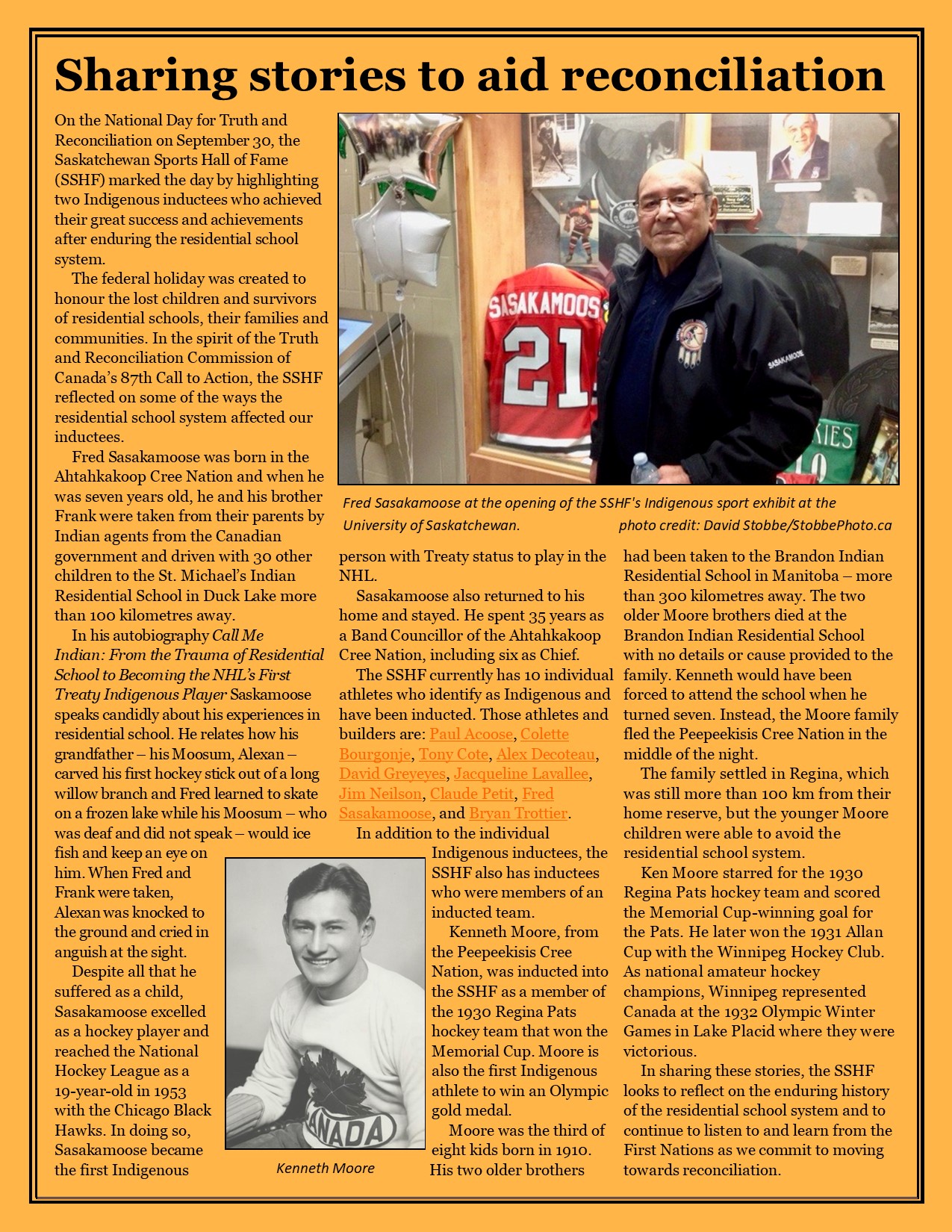
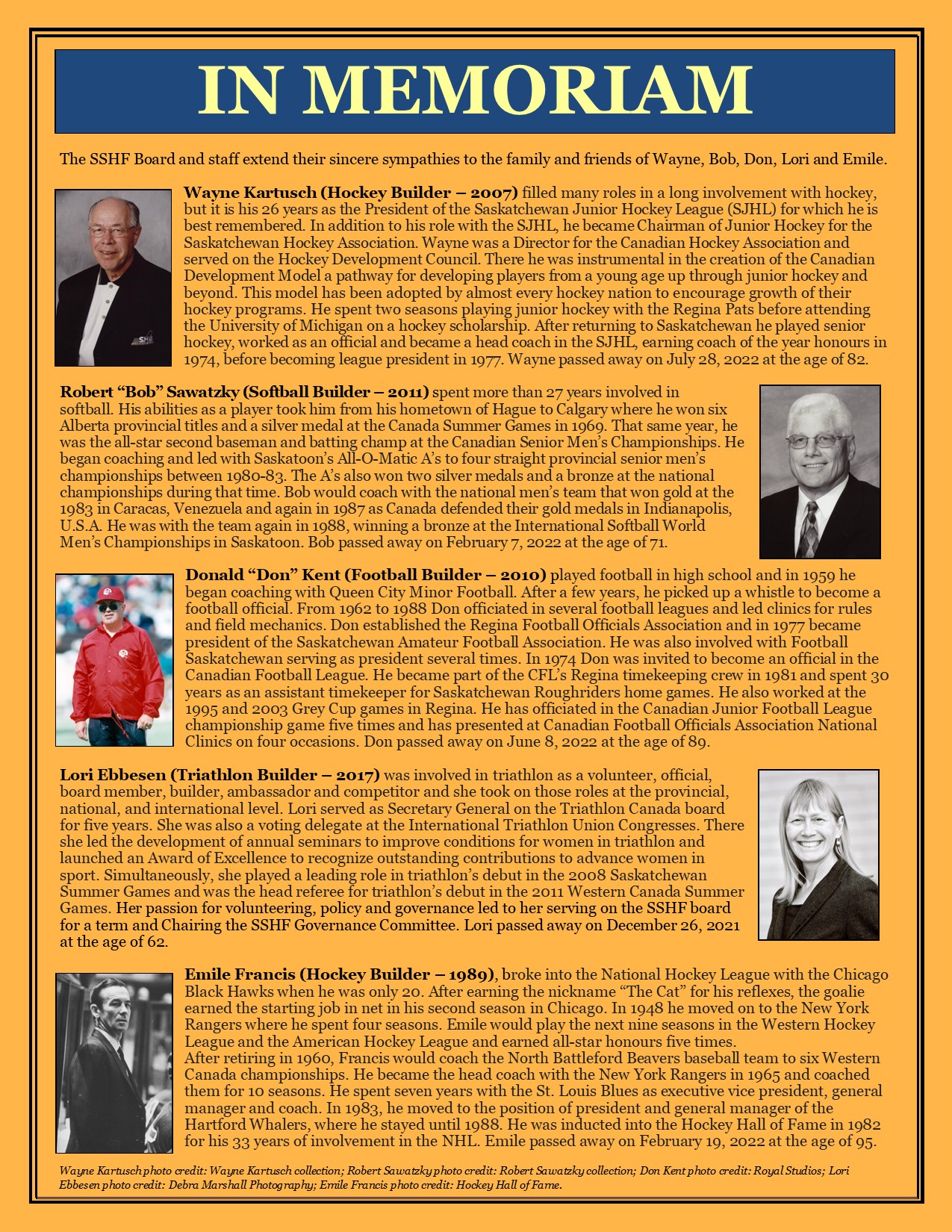

The fall 2022 edition of Never Give Up kicked off Tuesday afternoon with our first virtual presentation.
Inductee Arnold Boldt connected with three classes from Grades 5-8 from St. Augustine Community School in Regina to begin this latest five-week offering of this Saskatchewan Sports Hall of Fame educational program.
Never Give Up is an education program targeting at-risk students in Grades 4-8 which focuses on answering the question: what makes a person a “hero”? By discussing the concept of a hero, Never Give Up allows the students to understand that heroes are different for everyone and often they take the form of positive role models throughout each person’s community. Never Give Up is administered virtually and involves SSHF inductees who have overcome obstacles and hardships to achieve their own personal goals in sport and life. The students benefitting from this program represent a range of diverse life experiences and thus, so too do the presenters who currently include war refugees, amputees, and Paralympians.
This year the SSHF is happy to have inductee Ed Staniowski taking part for the first time. After spending parts of 10 seasons in the National Hockey League, Staniowski joined the Canadian Forces and reached the rank of Lieutenant Colonel.
Joining Staniowski are Boldt, Lisa Franks, and Colette Bourgonje who were among the presenters when Never Give Up was offered this past spring. In total 1,134 students took part in Never Give Up in the spring of 2022. These four presenters all have unique and engaging stories to share with students across the province. All 10 Never Give Up sessions have been filled this fall.
Never Give Up earned a pair of esteemed awards this past June. The SSHF was honoured with the Museums Association of Saskatchewan’s MAS Award of Merit – Institution (under $50,000.00) for 2022 for Never Give Up. The program was also honoured with the Canadian Association for Sport Heritage’s CASH Award of Excellence.
The SSHF is grateful to have sponsorship support from SaskTel in order to make this program possible.

Want something to do with your children this summer? Want to learn more about your favourite Saskatchewan sports and how to keep active? Then join our Creative Active Champions program!
You and your children will get a tour of the Saskatchewan Sports Hall of Fame, get active on our multisport simulator, adaptive curling rink, STEM Interactive Gallery sponsored by SaskTel, and play some outdoor games in Victoria Park.
After a fun-filled session, each participant leaves the program with a package containing one or two pieces of play equipment to encourage continued activity while supplies last.
The program is offered twice daily, Monday to Friday, from 10-11:30 a.m. and 1:30-3 p.m. Creating Active Champions runs from July 4 to August 19, 2022.
The program is for children aged 4-12. We encourage a donation of $1 for each participant and adult chaperones must be present at all times. All individuals and groups must pre-register. Please book early to avoid disappointment.
To register or for more information, please contact Vickie Krauss at (306) 780-9232 or email [email protected].
Creating Active Champions is led by Kyle and Sebastian. You can watch them demonstrate some of the interactive games that are part of the program and learn some of their Fanfare facts on our social media channels.
A special thank you to our Creating Active Champions sponsors Community Initiatives Fund and Sask Lotteries.
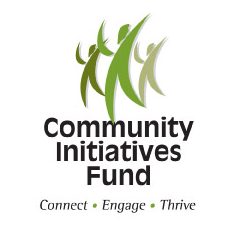
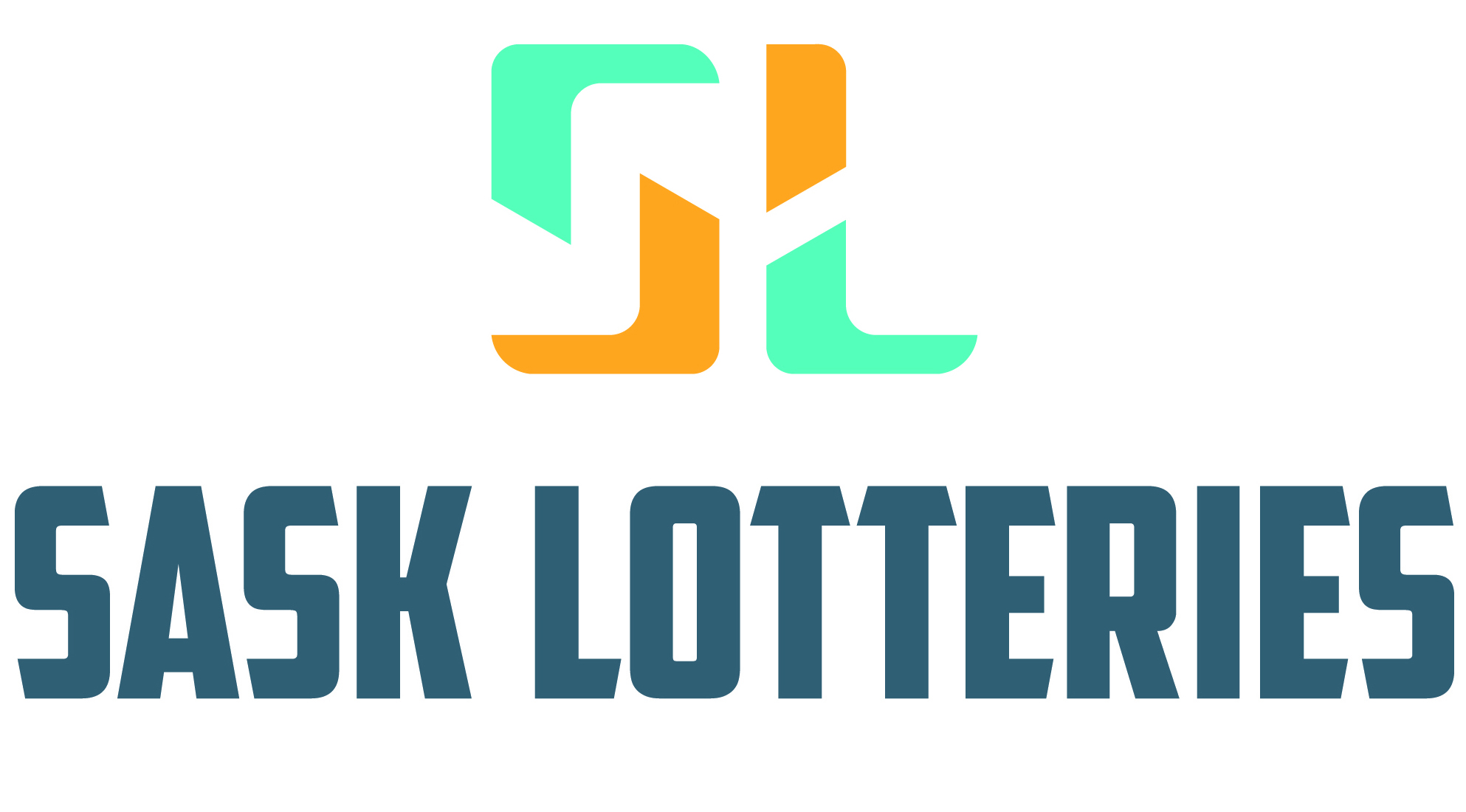

It has been some time in coming, but the Saskatchewan Sports Hall of Fame can’t wait to host our 54th Annual Induction Dinner & Ceremony at the Conexus Arts Centre in Regina on Saturday, September 24, 2022.
Two classes will be inducted concurrently at the ceremony as the Class of 2021 and the Class of 2022 are enshrined.
There are five members of the Class of 2022: Kelsie Hendry (Saskatoon – Athletics), Harry Jerome (Prince Albert – Athletics), Rueben Mayes (North Battleford – Football) in the athlete category plus Antonia “Toni” Beerling (Rosthern – Athletics) and Bill Brownridge (Vawn – Hockey) in the builder category.
The Class of 2021 features athletes Justin Abdou (Moose Jaw – Wrestling), Rod Boll (Fillmore – Trapshooting), Colette Bourgonje (Porcupine Plain – Athletics and Cross-Country Skiing), Kaylyn Kyle (Saskatoon – Soccer), and Lyndon Rush (Humboldt – Bobsleigh). Shannon Miller (Tisdale – Hockey) joins the 2021 class as a builder and the 2000-01 University of Regina Cougars Women’s Basketball Team and the 2013 Saskatchewan Roughriders Football Club are being inducted as teams.
The Atlas Hotel (4177 Albert Street, Regina) is the host hotel for the 54th Annual Induction Dinner & Ceremony.
The Atlas’ cancellation policy is as follows:
The Block hold will be released on August 26, 2022. Individuals can still reserve rooms but now it will depend on availability and may be at a different rate.
The Induction Dinner & Ceremony would not be possible without the support of our numerous official induction sponsors.
Official Induction Sponsors
Hotstove Presenting Sponsor and Broadcast Sponsor
Access Communications
Inductee Vignette Presenting Sponsors
Information Services Corporation
Saskatchewan Lotteries
Fire Cube Video
Photography Sponsor
Designer Photo Regina – Bruce Vasselin
Print Sponsors
Signature PrintIt
TG Marketing
Hosting Sponsors
Robertson Stromberg LLP
Barker’s Trophies
MLT Aikins
Conexus Arts Centre
Prairie Plastic Engraving
The Atlas Hotel
Ticket sales for the Induction Dinner & Ceremony have closed.

June 21 is National Indigenous Peoples Day. In the spirit of the Truth and Reconciliation Commission of Canada’s 87th Call to Action, the Saskatchewan Sports Hall of Fame marks this day by celebrating Indigenous excellence and achievement in sport. In doing so, the SSHF also looks to put a spotlight on the challenges and hardships that the SSHF’s Indigenous inductees overcame in achieving their goals.
The SSHF currently has 11 individual inductees who identify as Indigenous. Each has a unique story, but service to community and success over hardship are common themes with each athlete or builder.
Paul Acoose was from the Zagime Anishinabek (Sakimay) First Nation and came from a long line of distance runners. His competitive career was short, but he set a world record and defeated famed distance runner Tom Longboat before returning home to farm and raise a family.
Colette Bourgonje is a 10-time Paralympian and the first Canadian to compete in both a Summer and Winter Paralympics. Eighteen years after her Paralympic debut she won Canada’s first medal at the 2010 Paralympic Winter Games in Vancouver. There she also received the Whang Youn Dai Achievement Award, which is awarded each Games to a male and female athlete who best exemplifies the spirit of the Games “who prioritizes the promotion of the Paralympic Movement above personal recognition.”
Tony Cote had a lasting impact on the Cote First Nation where he created numerous athletic opportunities for young people. Those athletic opportunities extended across the province when he created the first Saskatchewan First Nations Summer Games in 1974. There is now a distinct Summer and Winter Games and they have both been named after Cote in his honour. Cote became Chief of the Cote First Nation also served during the Korean War.
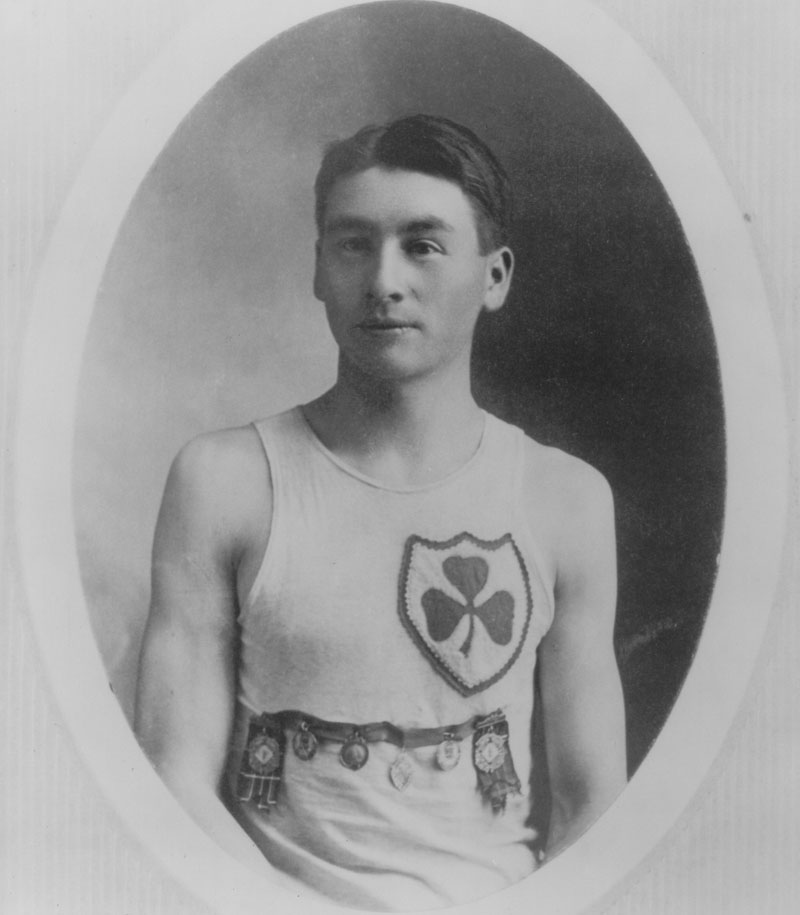
Alex Decoteau
Alex Decoteau has the distinction of being the first athlete born in what is now known as Saskatchewan to compete at the Olympic Games. Decoteau, from the Red Pheasant Cree Nation, finished sixth in the 5,000-metre run at the 1912 Stockholm Games despite suffering from leg cramps. He would also become the first Indigenous police officer in Canada and was killed serving in the Canadian Expeditionary Force in 1917 during the First World War.
David Greyeyes was another SSHF Indigenous inductee who served in the military. Greyeyes served in the Canadian Army during the Second World War. While overseas, the gifted soccer player, was a member of the Canadian team that won the Inter-Allied Games in 1946. He was chosen to represent Saskatchewan against top touring English teams in 1937, 1938 and 1949 – a testament to his longevity as a top player.
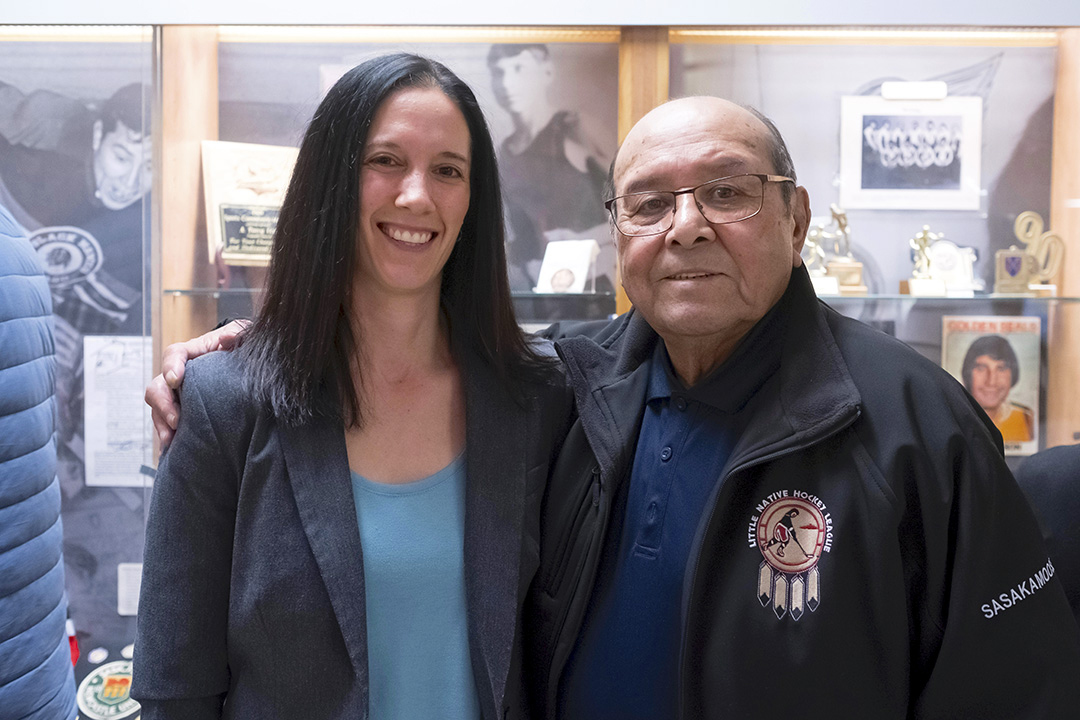
Jacqueline Lavallee and Fred Sasakamoose at the opening of the SSHF’s Indigenous sport exhibit at the University of Saskatchewan.
David Stobbe/StobbePhoto.ca
Jacqueline Lavallee was a two-sport star at the University of Saskatchewan where she was a Canadian Interuniversity Sport (CIS) All-Canadian in both soccer and basketball. She played for Canada at the World University Games twice and was a member of the women’s national basketball team for three years. She has been an assistant women’s basketball coach at the U of S for 14 seasons.
Ray Mitsuing was posthumously inducted as the first chuckwagon racer in the Hall of Fame in 2024 following his stories career that saw him qualify to compete at the Calgary Stampede for 36 consecutive years. In 1992 he won the Aggregate Championship at the Calgary Stampede and also earned the fastest time award there three times. He won the Canadian Professional Chuckwagon Association championship seven times during his distinguished career.
Jim Neilson was born in Big River, but grew up in an orphanage in Prince Albert. From those humble beginnings he would go on to play more than 1,000 games in the National Hockey League (NHL). Neilson spent 12 of his 16 years in the NHL with the New York Rangers where he played in a two NHL All-Star Games and finished fourth in voting for the Norris Trophy as the NHL’s best defenceman in 1968. He finished his career in 1979 playing alongside Wayne Gretzky during his rookie season in Edmonton.
Claude Petit also served in the Canadian Army during the Korean War and he too would compete athletically while serving overseas. Petit was a five-time Canadian Army heavyweight boxing champion and was also the only Canadian to win the British Army Heavyweight title. Inducted as a builder, Petit coached Team Canada at international competitions, worked as an official for several years and served nine years as president of the Saskatchewan Boxing Association.
Fred Sasakamoose was born in the Ahtahkakoop Cree Nation, but was taken from his family when he was six and suffered abuse at the St. Michael’s Residential School. Sasakamoose managed to thrive as a hockey player, being named the Most Valuable Player in the Western Canada Junior Hockey League. He made his debut in the NHL with Chicago in 1953-54 at the age of 19. His NHL career lasted 11 games, but his story had an enduring impact. Sasakamoose became an important community leader and served as Chief for six years. He reclaimed his language, becoming fluent in Cree later in life and worked to promote and develop sport programs for youth including the Fred Sasakamoose “Chief Thunderstick” Championship. In 2018 he was made a member of the Order of Canada.
Bryan Trottier is one of the most successful hockey players to come from Saskatchewan. He has won six Stanley Cups, the most of anyone in the province. Trottier scored 524 goals and had 1,425 points in 1,279 NHL regular-season games. He was also played in eight All-Star Games. The Hockey Hall of Famer wrote on the NHL website about his youth in Val Marie.

Kenneth Moore is inducted as a member of the 1930 Memorial Cup-champion Regina Pats hockey team. Moore would go on to win an Olympic gold medal in 1932 with a team based out of Winnipeg. Moore, from the Peepeekisis Cree Nation, is believed to be the first Indigenous person to win a gold medal for Canada. There is an excellent account of the toll the Residential School system had on the Moore family and how Kenneth’s parents were able to escape and spare him the same horrors that befell some of his siblings.
The Saskatchewan Sports Hall of Fame is proud to be located in Treaty 4 territory, home to the Cree, Dakota, Lakota, Nakoda, and Saulteaux people since time immemorial and are the traditional homelands of the Métis Nation. The Saskatchewan Sports Hall of Fame also celebrates the history of sport and the people from the land that is covered by Treaties 2, 4, 5, 6, 8 and 10. These lands have been the home of the Cree, Dakota, Dene, Lakota, Nakoda, and Saulteaux people since time immemorial and are the traditional homelands of the Métis Nation.
While National Indigenous Peoples Day is an ideal time to celebrate and share these stories and resources, reconciliation is an ongoing process.
The Saskatchewan Sports Hall of Fame expanded the Indigenous inductees exhibit at the Hall of Fame last year. The Hall now features an expanded permanent exhibit dedicated to Indigenous athletes and builders from Saskatchewan and this month the exhibit has a new addition — a dedicated display tablet with 5,400 words telling the stories of some of the province’s great Indigenous athletes.
In addition to the newly expanded Indigenous inductees exhibit, the Hall of Fame continues to offer Indigenous Legacies in Sport, an outreach educational program to students across the province. The Hall of Fame has also partnered with the University of Saskatchewan to create a display case and video kiosk celebrating Saskatchewan Indigenous athletes and their achievements. This exhibit is on permanent display in the Physical Activity Complex at the U of S’s College of Kinesiology in Saskatoon.

The Saskatchewan Sports Hall of Fame was honoured with the Museums Association of Saskatchewan’s MAS Award of Merit – Institution (under $50,000.00) for 2022.
The award was bestowed for the SSHF’s Never Give Up educational program during the Museums Association of Saskatchewan (MAS) Conference and Banquet in Estevan on June 10. The SSHF had previously won a MAS Award of Merit – Institution (budget over $100,000) in 2018 for the mobile exhibit trailer project.
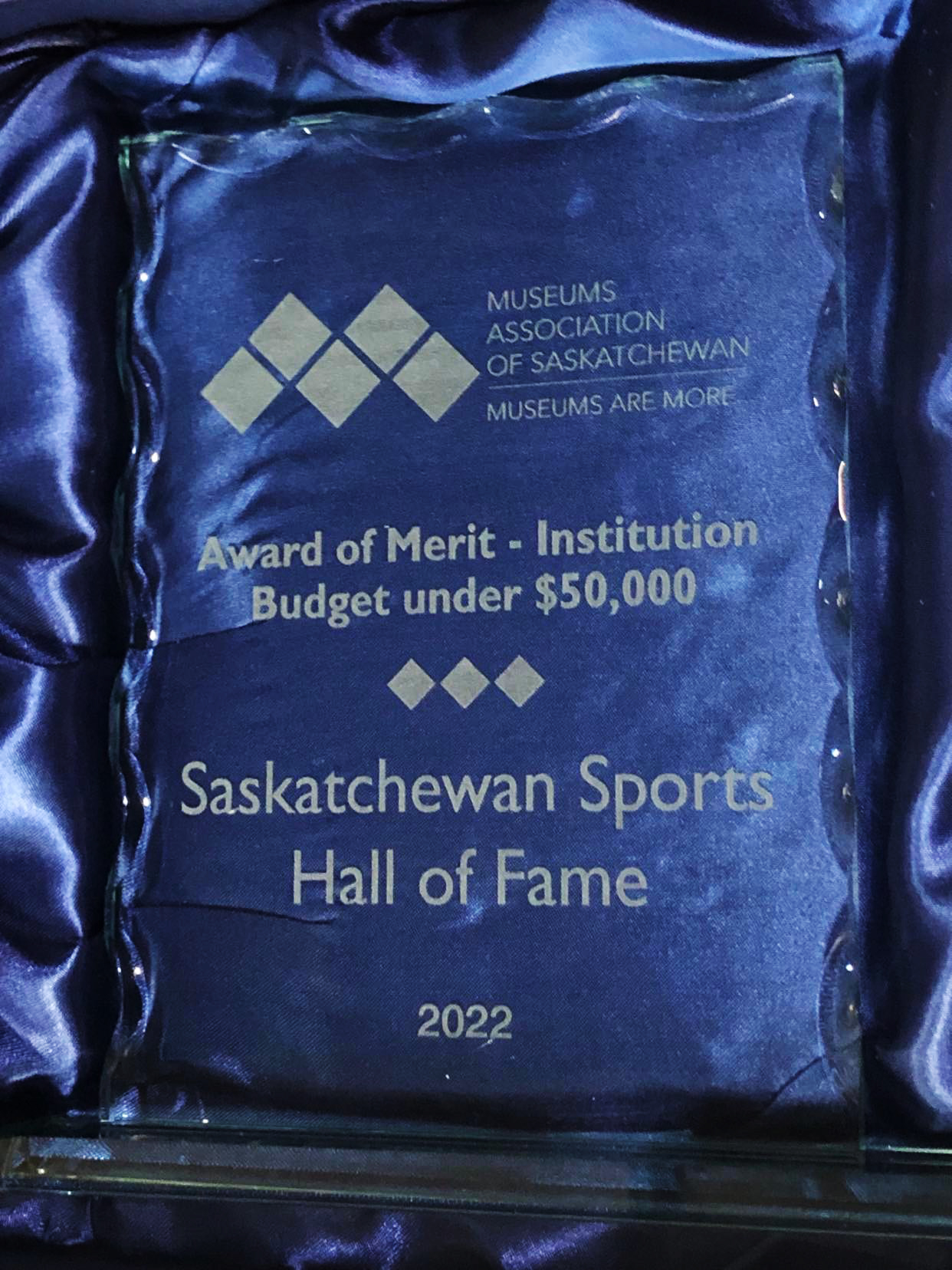
Never Give Up was also honoured with the Canadian Association for Sport Heritage’s CASH Award of Excellence on June 1.
Never Give Up is an education program targeting at-risk students in Grades 4-8 which focuses on answering the question: what makes a person a “hero”? By discussing the concept of a hero, Never Give Up allows the students to understand that heroes are different for everyone and often they take the form of positive role models throughout each person’s community. Never Give Up is administered virtually and involves SSHF inductees who have overcome obstacles and hardships to achieve their own personal goals in sport and life. The students benefitting from this program represent a range of diverse life experiences and thus, so too do the presenters who currently include war refugees, amputees, and Paralympians.
Never Give Up really hit its stride in 2021 when Covid-19 required that all education programming be conducted virtually. Over the course of 24 sessions (six weeks in May/June and six weeks in October/November), the program reached 35 different communities and a total of 2,047 participants. The SSHF is grateful to have sponsorship support from SaskTel in order to make this program possible.
Inductees Arnold Boldt, Lisa Franks, and Ted Jaleta, along with Colette Bourgonje – who will be inducted into the Hall of Fame this fall as a member of the Class of 2021 – shared their inspiring stories with students across the province.
Never Give Up just completed its spring run with 13 different communities across the province taking part across the 14 sessions. In total 1,134 students took part in Never Give Up in the spring of 2022.
Founded in 1968, MAS is a non-profit, collective organization of over 250 member museums and a total membership of over 400, including individuals and associates.

The Saskatchewan Sports Hall of Fame (SSHF) has won the Canadian Association for Sport Heritage’s CASH Award of Excellence for a second straight year.
This year, the SSHF was honoured for their Never Give Up education program at the Canadian Association for Sport Heritage (CASH) Annual General Meeting on Wednesday, June 1.
Never Give Up is an education program targeting at-risk students in Grades 4-8 which focuses on answering the question: what makes a person a “hero”? By discussing the concept of a hero, Never Give Up allows the students to understand that heroes are different for everyone and often they take the form of positive role models throughout each person’s community. Never Give Up is administered virtually and involves SSHF inductees who have overcome obstacles and hardships in order to achieve their own personal goals in sport and life. The students benefitting from this program represent a range of diverse life experiences and thus, so too do the presenters who currently include war refugees, amputees, and Paralympians.
Never Give Up really hit its stride in 2021 when Covid-19 required that all education programming be conducted virtually. Over the course of 24 sessions (six weeks in May/June and six weeks in October/November), the program reached 35 different communities and a total of 2,047 participants. The SSHF is grateful to have sponsorship support from SaskTel in order to make this program possible.
Inductees Arnold Boldt, Lisa Franks, and Ted Jaleta, along with Colette Bourgonje – who will be inducted into the Hall of Fame this fall as a member of the Class of 2021 – shared their inspiring stories with students across the province.

Colette Bourgonje delivers a Never Give Up presentation to a class in 2021.
In 2021, the SSHF won the inaugural CASH Award of Excellence for their exhibit Prairie Pride: A History of Saskatchewan Football.
The CASH Award of Excellence was created to recognize and celebrate the achievements of CASH members. Projects were eligible to be nominated from four categories: museum, events, communication and collection.
The CASH Award of Excellence was evaluated by the Awards Selection Committee using a point system.
CASH is comprised of 70 members and is a national association of institutions, organizations, and individuals dedicated to the preservation of Canada’s rich sports heritage.

The Saskatchewan Sports Hall of Fame (SSHF) held their Annual and Special Meeting on Thursday, May 26, 2022. The meeting minutes are now available.
The Bylaw change to clarify the language on Hall of Fame membership passed unanimously. The updated SSHF Bylaws can be found here.
Trent Blezy is the new Chair of the Hall of Fame and will begin a two-year term in the role. Robb Elchuk has completed two years as Chair and will move into the non-elected position of Past Chair. Rankin Jaworski has completed two years as Past Chair for a combined eight years on the board and will retire from the Board.
The other Officers of the Hall of Fame are Karen Meban, who is beginning her first term on the board and will assume the Vice Chair role. Mike Babcock remains in the role of Treasurer.
Mike Babcock and Tennille Grimeau were both re-elected to a second three-year term on the Board.
Babcock has been a member of the Board since 2017. He has a Bachelor of Commerce Degree (Honours) from Laurentian University and received his Certified General Accountants designation in 2007 and his Chartered Professional Accounts Designation in 2014 when the three national accounting designations unified. He opened his own accounting practice in 2016.
Grimeau is originally from Melville and received a Diploma in Hospitality & Tourism Marketing and a Masters Certificate in Project Management. She spent 20 years in loyalty marketing with the Saskatchewan Indian Gaming Authority (SIGA) where she was responsible for the strategic development and marketing of the Players Club loyalty program for SIGA’s seven casino properties, including member acquisition, direct marketing, data analytics, and branding. In the fall of 2021, she began her new role at Federated Co-operatives Limited (FCL) in the position of Loyalty Manager, where she is responsible for supporting the successful build, operationalization, and implementation of a new consumer loyalty program across Western Canada.

Eight members of the 2022-23 SSHF Board pictured during a board retreat: Karen Meban, back left, Tim Leier, Laurel Garvan, Robb Elchuk, Jeff Lightheart, front left, Cary Wessel, Tennille Grimeau, and Trent Blezy.
Four new Directors – Jeff Lightheart, Karen Meban, Christopher Weitzel, and Cary Wessel – were also elected for three-year terms on the SSHF Board.
Jeff Lightheart is a Certified Financial Planner and is the owner of a planning firm in Regina. He has a close affiliation with the Hall of Fame as his wife Nancy was a member of the 1991 Sundown Optimist Buffalo Gals who were inducted in 1996. Nancy’s sister, Jill Zimmer was also on that world championship-winning team. Jeff and Nancy’s daughters became baton twirlers and continue to be coached by another inductee, Maureen Johnson. If that weren’t enough, Nancy’s dad, brother, and uncle are also in the Hall.
Karen Meban is employed at CBC Regina as an Integrated Account Lead and has worked in media advertising sales for 22 years. She graduated from Laurentian University as a five-year veteran of the nationally-ranked Lady Vees basketball program. Upon graduation, and while starting her career, Meban was the assistant coach for the Lady Vees program before moving to Regina in 2003. She is the mother of three active kids and volunteers as a coach in basketball, ringette, and hockey.
Christopher Weitzel graduated from the University of Regina in 2000 with a BA and then went on to the University of Saskatchewan College of Law and Capital Law School earning his Juris Doctor (J.D.) in 2003 from the U of S. He is currently the Associate General Counsel – Corporate at Saskatchewan Government Insurance (SGI). His practice involves contract, procurement, privacy, litigation, and trademark issues as well as leadership responsibilities. He also earned his Certified In-House Counsel (CIC.C) designation in 2020 from Rotman School of Management and in 2020 received his Saskatchewan Queen’s Counsel (QC) designation. He is currently on the Canadian Bar Association Executive Board for Saskatchewan and was President of the CBA SK in 2020-21.
Cary Wessel graduated from the University of Regina in 2000 with a B.Sc. and then went on to the University of Saskatchewan College of Law earning his Juris Doctor (J.D.) in 2007. Wessel was called to the Bar of Saskatchewan in 2010. He is currently an Associate at Gerrand Rath Johnson LLP in Regina, where he practices in a wide array of legal areas, specializing in corporate and commercial matters. Wessel is active in several outdoors endeavours, including cycling, mountain biking, skiing, and camping. He is the Patrol Leader for Canadian Ski Patrol – Qu’Appelle Zone, involved as an instructor for Advanced First Aid, and a sitting executive with both the local zone and the provincial division.
OFFICERS OF THE HALL
Chair– Trent Blezy (Regina)
Vice Chair – Karen Meban (Regina)
Treasurer – Mike Babcock (Regina)
Past Chair – Robb Elchuk (Regina)
DIRECTORS
Samer Awadh (Regina)
Laurel Garven (Regina)
Tennille Grimeau (Saskatoon)
Tim Leier (Saskatoon)
Jeff Lightheart (Regina)
Kelvin Ostapowich (Regina)
Christopher Weitzel (Regina)
Cary Wessel (Regina)